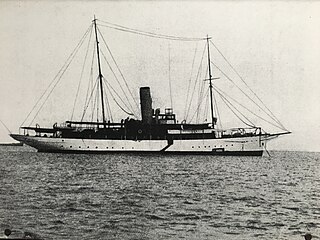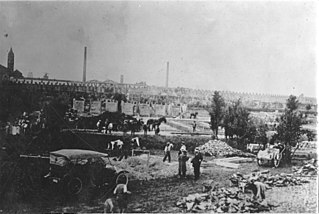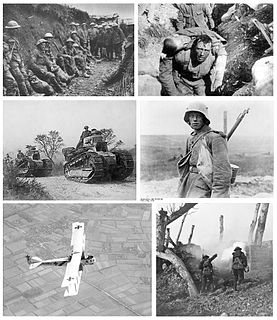 W
WThis article is about Italian military operations in World War I.
 W
WThis article is about Italian military operations in World War I.
 W
WThe Allied Victory Medal was the Italian variant of the Victory Medal of other nations. It was established by royal decree number 1918 on 16 December 1920, which granted it to all who had been awarded the "fatiche di guerra" distinction by royal decree number 641 of 21 May 1916, or who had served for four months in an area under the jurisdiction of the armed forces and who had been mobilised and directly worked with the operational army.
 W
WThe Armistice of Villa Giusti ended warfare between Italy and Austria-Hungary on the Italian Front during World War I. The armistice was signed on 3 November 1918 in the Villa Giusti, outside Padua in the Veneto, Northern Italy, and took effect 24 hours later.
 W
WThe Commemorative Medal for the Italo-Austrian War 1915–1918 was the Italian campaign medal for World War I.
 W
WElettra was the name of Guglielmo Marconi's steam yacht – a seaborne laboratory – from which he conducted his many experiments with wireless telegraphy, wireless telephony and other communication and direction-finding techniques during the inter-war period.
 W
WThe Flight over Vienna was an air raid during World War I undertaken by Italian poet and nationalist Gabriele D'Annunzio on 9 August 1918. With 11 Ansaldo S.V.A. from his team, the 87ma squadriglia (squadron) called La Serenissima all bearing the Lion of St Mark painted on their fuselage sides as the squadron's insignia, he flew for over 1,200 km in a round trip from the squadron's military airfield in Due Carrare to Vienna to drop thousands of propaganda leaflets.
 W
WThis articles covers the history of Italy as a monarchy and in the World Wars.
 W
WWhen World War I broke out in August 1914, Italy declared neutrality. Although nominally allied with the German Empire and the Empire of Austria-Hungary in the Triple Alliance, the Kingdom of Italy did not join the Central Powers; in fact, Germany and Austria–Hungary had taken the offensive while the Triple Alliance was supposed to be a defensive alliance. Moreover, the Triple Alliance recognized that both Italy and Austria-Hungary were interested in the Balkans and required both to consult each other before changing the status quo and to provide compensation for whatever advantage in that area: Austria-Hungary did consult Germany but not Italy before issuing the ultimatum to Serbia, and refused any compensation before the end of the war. Italy negotiated for a better deal with the Allies, especially in terms of gaining territory from the Austro-Hungarian Empire. However, Russia had its own pro-Slavic interest in that region, and complicated negotiations. Russia's negotiating position was greatly weakened by its heavy military losses. London and Paris insisted and Russia, by April 1915, abandoned its support for most of Serbia's claims and accepted terms for Italy's entry into the war, which would limit the Russian strategic presence in the postwar Adriatic. Italy accepted the Allies’ offer in which Italy would receive a slice of Austria and a slice of the Ottoman Empire after the defeat of Austria-Hungary. This was formalised by the Treaty of London. In 1915, Italy entered the war joining the Triple Entente.
 W
WAround 600,000 Italian soldiers were taken prisoner during the First World War, about half in the aftermath of Caporetto. Roughly one Italian soldier in seven was captured, a significantly higher number than in other armies on the Western Front. About 100,000 Italian prisoners of war never returned home, having succumbed to hardship, hunger, cold and disease. Uniquely among the Allied powers, Italy refused to assist its prisoners, and even hindered efforts by soldiers’ families to send them food. As a result, the death rate for Italian prisoners was nine times worse than that of Austro-Hungarian prisoners in Italy.
 W
WMilitary cableways were used in the First World War by the Italy and Austria-Hungary to transport supplies up to their troops in mountain sectors of the front. Troops were often in high-altitude positions during the so-called “White War”, far removed from roads, mule tracks, pathways or existing cablecars. Moreover, where such infrastructure did exist, it generally followed the easiest routes and was therefore exposed to enemy fire. Providing the troops on the front line with a reliable supply of food and ammunition therefore often required the building of new infrastructure.
 W
WThe Pisa Village was a humanitarian housing project in Italy partially completed by the American Red Cross (ARC) during World War I.
 W
WIn Italy as in other countries the outbreak of the First World War created new opportunities and channels for propaganda. The unusual circumstances of Italy’s entry into the war meant that the government played no active role in propaganda work during the early years of the war. Public opinion was served by a pro-war nationalist press that avoided the unpleasant details of life in the front, while the army regarded discipline as more important than morale, leaving soldiers’ welfare to the Church. The momentous Italian defeat at Caporetto saw an end to this laissez-faire approach and the beginnings of a more centralised and managed effort to motivate the public and the army to the national cause.
 W
WThe U-boat Campaign from 1914 to 1918 was the World War I naval campaign fought by German U-boats against the trade routes of the Allies. It took place largely in the seas around the British Isles and in the Mediterranean. The German Empire relied on imports for food and domestic food production and the United Kingdom relied heavily on imports to feed its population, and both required raw materials to supply their war industry; the powers aimed, therefore, to blockade one another. The British had the Royal Navy which was superior in numbers and could operate on most of the world's oceans because of the British Empire, whereas the Imperial German Navy surface fleet was mainly restricted to the German Bight, and used commerce raiders and unrestricted submarine warfare to operate elsewhere.
 W
WThe Western Front was the main theatre of war during the First World War. Following the outbreak of war in August 1914, the German Army opened the Western Front by invading Luxembourg and Belgium, then gaining military control of important industrial regions in France. The German advance was halted with the Battle of the Marne. Following the Race to the Sea, both sides dug in along a meandering line of fortified trenches, stretching from the North Sea to the Swiss frontier with France, which changed little except during early 1917 and in 1918.